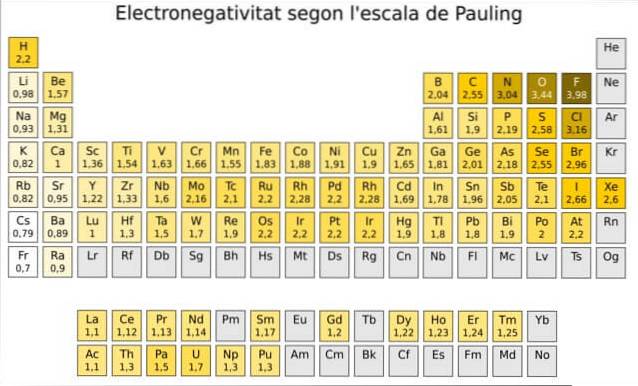
Pauling scale electronegativity and energy difference

The Pauling scale is an arbitrary scale used in chemistry to express the electronegativity of the elements. This is defined as the tendency of a certain atom to attract electrons when combined with another atom.
In this sense, elements with high electronegativity tend to gain electrons easily. These are the non-metals, while for their part, less electronegative elements such as metals, it is easier to give up electrons.

Therefore, knowing the electronegativity of an element, one has an idea of the type of bond that it is capable of forming when combined with another. We will see this with a numerical example later..
With this information, many of the properties that a compound will have can be predicted, something very useful in experimental chemistry and for materials science, where novel compounds are continually being created..
However, it is convenient to clarify that despite how important it is, there is no single way to determine electronegativity; The Pauling scale is only one of the various ways proposed to find it, although it is one of the most used.
In fact, Pauling's is an arbitrary scale in which a numerical value is assigned to each element in the periodic table, which reflects its electronegativity. We see it in figure 1, where we have the electronegativity of each element, as it was assigned by the two-time Nobel laureate Linus Pauling (1901-1994) around 1939..
Article index
- 1 The electronegativity of the elements
- 1.1 Electronegativity in the periodic table
- 2 Binding energy difference
- 2.1 Equations for electronegativity
- 3 Example
- 3.1 Solution
- 4 References
The electronegativity of the elements
Pauling, together with Don M. Yost, found the electronegativity values empirically, through experimental data obtained by measuring bond energies..
Pauling assigned the element fluorine - above and to the right of the table in Figure 1 - the highest electronegativity, with the number 4.0. So when fluorine forms bonds, it exhibits the highest tendency to attract electrons of all elements..
Second is oxygen with 3.5 and third is nitrogen with 3.0. Both are located at the top and to the right of the table.
On the other hand, at the opposite extreme, the least electronegative element is cesium, whose symbol is Cs, located to the left of the table, to which Pauling assigned the number 0.7.
Electronegativity in the periodic table
In general lines and as can be seen in figure 1, electronegativity -and ionization energy- increases from left to right in the periodic table. The general trend also indicates a decrease when moving from top to bottom.
Therefore, we will have the most electronegative elements in the upper right corner of the table: fluorine, oxygen, chlorine, nitrogen. The least electronegative -or the most electropositive if you prefer- will be found on the left: lithium, sodium, potassium and the other elements of group 1 -the column on the extreme left, corresponding to the alkali and alkaline earth metals.-.
In each column, the electronegativity decreases as the atomic number of the element increases, except for the transition metals in the center, which do not follow this trend..
An important point to note is that electronegativity is relative, it is not an invariable property of each element, and it is only measured with respect to that of other elements. It depends a lot on the oxidation state, so the same element can exhibit different electronegativity, depending on the type of compound it forms..
Binding energy difference

In chemistry, a bond is the way that atoms, the same or different, join together to form molecules. Between the atoms appear forces that hold them together in a stable way.
There are several types of link, but here two are considered:
-Covalent, in which atoms of similar electronegativities share a pair of electrons.
-Ionic, frequent between atoms with different electronegativities in which electrostatic attraction prevails.
Suppose that two elements A and B can form molecules with each other, denoted AA and BB. And that they are also capable of joining to form an AB compound, all through some type of bond.
Thanks to the participation of intermolecular forces, there is energy in the bond. For example the energy in bond AA is EAA, in bond BB it is EBB and finally in compound AB it is EAB.
If the molecule AB were formed by a covalent bond, theoretically the binding energy is the average of the energies EAA and EBB:
ANDAB = ½ (EAA + ANDBB)
Pauling calculated EAB for various compounds, he measured it experimentally and determined the difference between both values, which he called Δ:
Δ = | (EAB) measured - (EAB) theoretical | = | (EAB) measured - ½ (EAA + ANDBB) |
Pauling reasoned like this: if Δ is very close to 0, it means that the electronegativities of both elements are similar and the bond that joins them is covalent. But if Δ is not small, then the bond between A and B is not pure covalent.
The greater the absolute value of Δ, the greater the difference between the electronegativity of elements A and B and therefore the bond that joins them will be of the ionic type. Later the reader will find an example in which, by calculating Δ, it is possible to determine the type of bond of a compound.
Equations for Electronegativity
Assuming that the difference in energies is the signal that distinguishes the nature of the bond, Pauling carried out many experiments that led him to create an empirical expression for the relative electronegativities of two elements A and B that form a molecule..
Denoting this electronegativity as χ (Greek letter “chi”), Pauling defined Δ as follows:
Ftwo· Δ = [χ (A) - χ (B)]two
χ (A) - χ (B) = f√Δ = 0.102√Δ
Note that Δ is a positive quantity. The factor f = 0.102 that appears by multiplying the square root of Δ is the conversion factor between kJ (kilojoules) and eV (electron-volt), both units of energy.
If instead kilocalories and electron-volts are used, the difference in electronegativities is expressed with a similar formula but with f = 0.208:
χ (A) - χ (B) = 0.208√Δ
Pauling began by assigning hydrogen a value of 2.1, a previous value obtained by chemist Robert Mulliken. He chose this element as his starting point because it forms covalent bonds with many others..
Using the previous equation, he continued assigning relative values to the rest of the elements. Thus, he realized that electronegativity increases when moving from left to right and from top to bottom in the periodic table, as described in the previous section..
Example
Below is a list of elements: N, J, Y and M and their respective electronegativities Χ according to the Pauling scale:
-N: Χ = 4.0
-J: Χ = 1.5
-Y: Χ = 0.9
-M: Χ = 1.6
Among the following compounds formed with them:
YJ, YN, MN and JM
Indicate the one with the highest ionic character and the one whose nature is covalent. Reason for your answer.
Solution
According to the criteria established by Pauling, the compound with the greatest ionic character will be the one with the greatest difference between electronegativities, and therefore a greater value of Δ. For its part, the compound with the smallest energy difference is the one with a covalent bond.
Then we will calculate how much Δ is worth for each compound, as follows:
Composite YJ
Δ = [χ (Y) - χ (J)]two = (0.9 - 1.5)two = 0.36
Composite YN
Δ = [χ (Y) - χ (N)]two = (0.9 - 4.0)two = 9.61
Composite MN
Δ = [χ (M) - χ (N)]two = (1.6 - 4.0)two = 5.76
Composite JM
Δ = [χ (J) - χ (M)]two = (1.5 - 1.6)two = 0.01
From the above results, it follows that the ionic compound is YN, whose Δ = 9.61, while the covalent compound is JM, with Δ = 0.01.
References
- Chemistry Libretexts. Pauling Electronegativity. Recovered from: chem.libretexts.org.
- IUPAC Gold Book. Electronegativity. Recovered from: goldbook.iupac.org.
- Salas-Banuet, G. The misunderstood electronegativity. Recovered from: scielo.org.
- Scientific texts. Electronegativity. Recovered from: textscientificos.com.
- Whitten, K. 2010. Chemistry. 9th. Ed. Brooks / Cole. Cengage Learning.
- Wikipedia. Covalent bond. Recovered from: es.wikipedia.org.
- Wikipedia. Ionic bond. Recovered from: es.wikipedia.org.



Yet No Comments